
The Old World of Corporate Budgeting and Its Shortfalls
Corporate Budgeting has traditionally been an activity complained about by business leaders as being an unproductive and non-value-added task. Despite that annual budgeting was a prudent financial activity for the organization to properly plan investments or satisfy bank requirements, that sentiment commonly shared by businesses still had some merit.
Silos and Lack of Ownership
The process tended to be conducted in a silo that fell primarily on the Finance department without properly engaging leaders across the business, which would naturally lack the ownership by business leaders to hold themselves accountable for those targets. Alternatively, when business leaders were engaged in the corporate budgeting process, many times it was seen as being disruptive to normal business activities without proper structure, guidance, and data. Then after the business leaders spent time preparing the budget, that would be the last time they would see or hear about it until next year’s budgeting cycle.
Manual and Time Consuming
Budgeting and reporting are still largely done manually and in spreadsheets, which is very time-consuming and leaves little time for valuable Finance resources to provide value-added analysis. In many cases, organizations will build large coporate budgeting workbooks with many spreadsheets requiring inputs from budget contributors. These budget workbooks are then sent out by email or loaded onto a file share, where people fumble around entering their budgets while trying not to break formulas and links. The Finance team then spends time tracking down the workbooks and keeping people on track to complete them by a deadline. At which point the Finance team spends time manually pulling together all of the budget data across the various workbooks to compile a rolled-up view of the budget for review. If further revisions or drafts are required, then it must go through this whole cycle again. While there are opportunities to simplify it, living in a “spreadsheet and email” world does not lend itself to agility and innovation.
Stagnant and Not Relevant
From a reporting standpoint, the annual budget would rapidly lose relevance as the year progressed because it did not capture assumptions that needed to be reassessed as well as new information that was unknown prior to the start of the year. The budget eventually becomes meaningless to the business leaders and did not enable better decision making such as being able to assess, plan, pivot the business and understand what the forward-looking impact would be.
The old world of coporate budgeting and reporting clearly has had its challenges and shortfalls. However, organizations have been forced to re-think the process due to increasing business demand and competitive pressure.
FP&A, xP&A & Where Things Are Going
Organizations have been increasingly investing in Financial Planning and Analysis (FP&A) practices and resources, which focuses on the ongoing feedback cycle of planning, budgeting, forecasting and analytics. This movement has helped graduate organizations from an incongruent annual process to something that was more continuous and integrated into the business rhythm.
Integrated Into Business Rhythm
Many organizations have instituted a formal FP&A process and assigned resources to help manage the process of better distilling high-level corporate plans into detailed driver-based budgets, continuous forecasts of the financial outlook as the year progresses, and value-added analysis for all levels of the organization. In addition to forecasting, re-forecasting has become an increasingly important component of FP&A where the forward-looking periods are more frequently re-assessed and adjusted to factor in new information such as changes to business, competitive factors, cost drivers, and new opportunities. This is done to provide an outlook that is more in-line with reality to better enable business leaders to be proactive, drive growth and mitigate risk, rather than working with a stale budget. Making FP&A an integral part of the business rhythm, makes it less disruptive and better set up for success.
Broader Scope and Collaboration
FP&A has grown into something more holistic, collaborative across business, and real time – which is now being referred to as Extended Planning & Analysis (xP&A). While FP&A tools (corporate budgeting, planning, forecasting, and reporting) were previously only used and owned by Finance, they are becoming increasingly available across all business units and functional areas of the business (Sales, HR, Operations, IT, etc.). FP&A tasks used to be sole duties owned by a Finance resource and are now becoming listed in the job descriptions of business leaders. This is helping the organization plan better by assigning accountability and ownership is held at the right levels of the business and equipping them with the tools and training to succeed.
Enhancing Business Processes with Technology
Modern FP&A & xP&A platforms are now providing more functionality than many organizations could wish for compared to what their spreadsheets and email can offer.
Historically organizations rely on analysts to extract data from systems and manually update reports and distribute to the business. These platforms are integrated with key source systems (such as ERP, CRM, and POS) and continually updated with the latest data (financial and non-financial), enabling organizations to monitor their performance and update forecasts in a timelier fashion.
Another aspect of this is better utilizing non-financial data to enhance planning and monitoring. Certain non-financial data points are critical drivers that help us build our plans, such as headcount, time sheets, membership/subscriber count, production volumes, raw material consumption, transactions processed, etc. Other data sets can help supplement reporting and monitoring as potential leading indicators of if we are on track to achieve our goals and help better understand our performance in a more holistic way. Examples could include customer growth/retention, customer satisfaction, employee engagement ratings, absenteeism, social media sentiments, etc.
We are now able to set up early warning triggers and alerts based on business logic and thresholds, that were only available with complex custom coded applications. This can draw people into the system to act based on how performance of a particular business is trending, intervene with spend that is exceeding the pace that was planned for, and address trends in headcount levels that are required to deliver on forward looking commitments. So much can be done here by leveraging the understanding of the business and its drivers to set up alerts that can notify us before it is too late.
Given all these advancements in xP&A providing more enhanced and integrated planning and analysis, being able present the reporting and analytics in a digestible and summarized fashion is tremendously valuable to leadership. These platforms provide rich data visualization capabilities as well as the ability to replace static PDF report packages of the past with interactive flip books with drill-down capabilities. These changes help leadership draw insights and act, without having to sift through static documents, spreadsheets and tables of data.
How To Get There
The natural next question is what the next steps are to get there. In summary, the goal is to:
- Make “xP&A” a part of every leader’s job description
- Update business rhythm to make time for this ongoing exercise
- Select the right tools/platform to support your organization
- Provide training and resources to set your leaders up for success
Naturally organizations may have doubts related to concerns about capacity constraints, perceptions of complexity, cumbersome planning process or design, availability of data and general understanding. Despite these concerns, it is more achievable than you can think, and this can be done in a phased approach without too much disruption.
Ready to Transform Your Corporate Budgeting, Planning, Reporting & Corporate Performance Management? We Can Help!
With over 30 years of experience helping companies implement and optimize corporate performance management software, our team of experts is here to help analyze your existing processes and recommend the right solution to meet your needs.

;)



